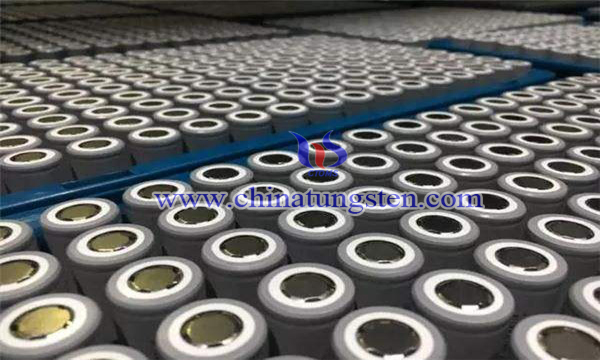Tungsten Carbide-Coated Anode
- Details
- Category: Tungsten Information
- Published on Friday, 20 July 2018 16:09
In the 21st century, energy and environmental pollution have become a worldwide problem. The development and application of new energy sources is imminent. Lithium-ion batteries have advantages such as high operating voltage and high specific energy, and have been applied to portable electronic products such as laptops, mobile phones and digital cameras. In recent years, the rapid development of full electric vehicles and hybrid electric vehicles has provided a huge market prospect and high-speed development for lithium-ion batteries. It also poses new challenges for performance improvement and cost reduction of lithium-ion batteries.

The anode material has always been a bottleneck restricting the performance improvement and cost reduction of lithium ion batteries. Lithium iron phosphate (LiFePO4) is the preferred cathode material for modern commercial lithium-ion batteries because of its low price, high energy density, long life and safety. However, the low electrical conductivity of lithium iron phosphate has aversively hindered its application in the field of power batteries and energy storage batteries.
Coating is one of the effective ways to improve the conductivity of lithium iron phosphate materials. Some researchers have proposed a tungsten carbide-coated anode, with which a tungsten carbide (WC) shell coated on lithium iron phosphate anode. The tungsten carbide coating provides an excellent electrical conductivity and improved rate characteristics of lithium iron phosphate anode. The coating processes are as follow:
The first step is to weigh 0.1 mol of ferrous sulfate, 0.11 mol of lithium chloride and 0.1 mol of ammonium dihydrogen phosphate, respectively, dissolved in 200 ml of deionized water, mixed together and poured into a hydrothermal reaction tank, and added with ammonia to control the pH to 9.0. Then, it was placed in a heater and reacted at 200 ° C for 24 h. After cooling, the precipitate was repeatedly centrifuged with deionized water, and the separated powder was vacuum dried at 100 ° C for 10 h to obtain lithium iron phosphate.
Next, the lithium iron phospahte in last step was placed in a reaction chamber of a plasma enhanced chemical vapor deposition apparatus, evacuated to 1.0 × 10-1 Pa, and heated to 300 °C. The mixed gas of WF6+CH4 (WF6:CH4=1:1 volume ratio) was charged, and the total gas pressure of the reaction chamber was maintained at 50 Pa. The RF plasma has a power output of 600W and a reaction time of 25 minutes. A lithium iron phosphate anode coated with a tungsten carbide shell layer was obtained, and the coating layer was 1.0 nm thick. The 1C first discharge capacity was 155 mAh•g-1, and the 5C/1C discharge retention rate is 98%.
The prepared tungsten carbide shell-coated lithium iron phosphate cathode material has excellent rate performance. With the metal lithium button-type analog battery test, in the range of 2.5-4.35V, the first discharge capacity of 1C is ≥155mAh•g-1, and the discharge retention rate of 5C/1C is above 96%.
- Tungsten Carbide Manufacturer & Supplier, Chinatungsten Online: tungsten-carbide.com.cn
- Tungsten News & Prices of China Tungsten Industry Association: www.ctia.com.cn
- Molybdenum News & Price: news.molybdenum.com.cn
- Tel.: 86 592 5129696; Fax: 86 592 5129797; Email: sales@chinatungsten.com



 sales@chinatungsten.com
sales@chinatungsten.com